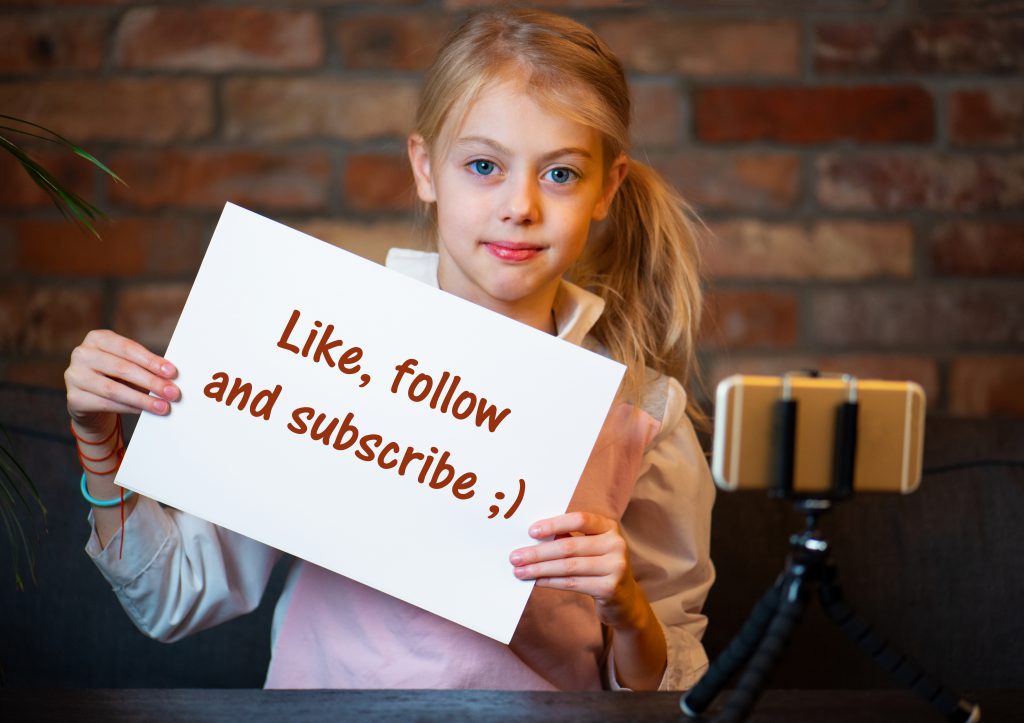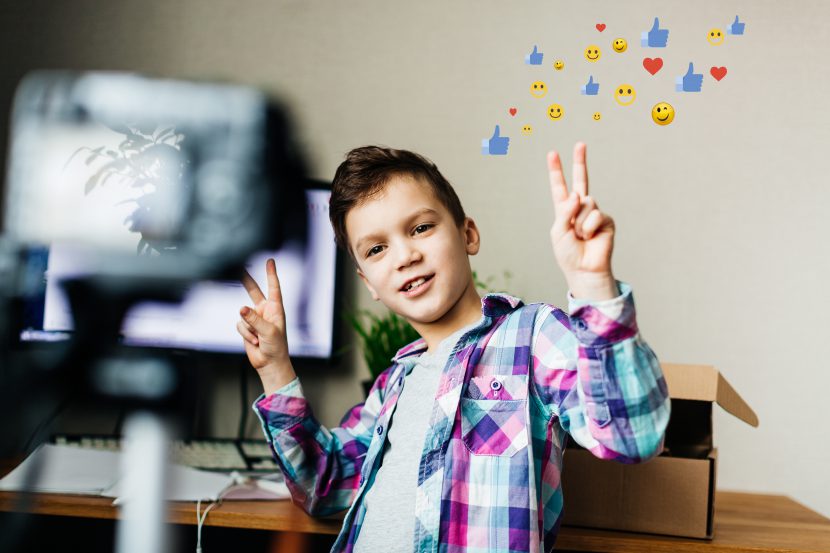Influencer marketing is one of the fastest-growing segments of the corporate industry; the attention of the masses is just one easy, accessible click away (60 Minutes Australia, 2020). Personal media sources such as home videos have quickly become a lucrative market, which raises stern questions about the role of parents in safeguarding their children’s rights in this new commercial space. The dark cloud hanging over this new phenomenon is the fact that parents simultaneously have the power to profit off their children’s participation in this commercial activity, but also the responsibility to safeguard their human rights (60 Minutes Australia, 2020).
In the past few years, “Kidfluencers” – children with large social media followings – have catalysed an $8 billion social media advertising industry, with highly ‘successful’ children generating up to $26 million a year through advertising and the sharing of sponsored content (Masterson, 2020). Children are at grave risk of exploitation because they lack the legal right to the earnings they generate, or safe working conditions and protections via labour laws (Masterson, 2020).
In fact, many jurisdictions are so deferential to parental rights to make autonomous decisions when raising their child that there is little to no regulation of the production of social media content involving children (Langford, 2020). There is a strong case for expanding existing legislation, which protects child labourers and performers, to encompass children’s participation in social media content.
Who are “Kidfluencers?”
Kid Influencers or “Kidfluencers” are children who have been posted online on different social media platforms generating large numbers of viewers and followers, often earning money for sponsored content (Masterson, 2020). Most social media platforms such as Instagram and YouTube require users to be 13 years old or older to create accounts on their websites. As a result, most “Kidfluencers” parents manage their accounts in order to sustain their online presence.
Famous “Kidfluencers” such as Ryan Toys Review on YouTube (an account that currently has 28 million subscribers) are under constant pressure to produce content on a regular basis (CBS, 2019). 7-year-old Ryan Kaji, the child at the centre of the channel, earned an estimated $22 million in 2018 (Lambert, 2019). Ryan is one of many children at the heart of the industry in which families of “Kidfluencers” receive compensation for sponsored content promoted on social media platforms, digital advertisements and merchandising (Masterson, 2020). The large sums of money involved in the industry provide a strong incentive for parents and guardians, elevating the level of child vulnerability.
“Kidfluencers” with one million followers or more are able to earn $10,000 or more per sponsored post (CBS, 2019). Perhaps most worrying is the absence of legislation and policy for the protection of children involved in this practice. Though child actors are able to gain access to numerous protection mechanisms, “Kidfluencers” are treated differently because their activity takes place in a private home setting on a platform in which parents consensually participate (Masterson, 2020). Their activity fails to be viewed as ‘work’ due to the absence of an employer-employee relationship and the fact that children are deemed to be undertaking normal activities on camera rather than putting on a “performance” (Masterson, 2020).

In spite of this, the same harms exist for “Kidfluencers” as child actors. Loss of privacy, child labour, child exploitation and deprivation of other opportunities (such as missing school) are all common risks – as well as the additional physical and psychological harms such as exploitative practices due to the unregulated nature of the social media space (Masterson, 2020). Without labour laws or work permits, children are exposed to infinite working hours with no regulations around their well-being or rest and recreation times (Wong, 2019).
There is also a risk that these children are taken out of education to earn money to which they have any legal right (Wong, 2019). The argument can be made that this is an example of illicit enrichment and self-dealing, as parents are consenting to the use of their child’s image in advertising for profit (Wong, 2019). Notwithstanding this, the practice remains common, with the influencer marketing industry expected to grow to $15 billion by 2022 (Mooney, 2019).
Child Labour Laws and Coogans Law
While there are regulations and rules in the child entertainment industry, these provisions rarely apply to “Kidfluencers”. Coogan’s Law, originating in California in 1939, provides a template for the ways in which new legislators could act to better protect children. It was created off the back of Jackie Coogan, a child actor who discovered, at the age of 21, that his parents had spent all of his earnings from his film career (Masterson, 2020). To guard against this, the law ensures that parents must establish a protected trust account to deposit a portion of the child actor’s wages until they are 18 years of age (Masterson, 2020).
Lawmakers unsuccessfully attempted to revise the bill to include “social media advertising” in 2018 (Lambert, 2019). The law (and others) exists to protect children from big corporations and safeguard against the risk that children could easily be exploited in working arrangements (Whyte, 2019). Conventionally, laws such as these have failed to apply to “Kidfluencers” who exist in a ‘grey zone’ blurring the line between work and home (Whyte, 2019).
More recently in 2020, France has enacted new legislation (coming into force in April 2021) to specifically respond to the “Kidfluencer” phenomenon. Under the novel provision – ‘the Exploitation of the image of children on all online platforms bill’ – all the money that children earn if they are under the age of 16 will be protected (Cuthbertson, 2020). This innovative new law further enshrines the “right to be forgotten” which means that social media platforms are obligated to remove child content at the request of the child (BBC, 2020).
While the law does not protect all children, it ensures that “Kidfluencers” are sufficiently protected (BBC, 2020). Under the law, parents are obligated to receive government authorisation before their child is engaged in online activities that amount to a ‘labour relation’ (an arrangement which resembles an employee-employed experience). Other provisions such as the Childhood Online Privacy Protection Act (COPPA) have considered extending work permits to online spaces, in an attempt to regulate the digital space (Langford, 2020).
“Kidfluencers” and Child Exploitation: An inseparable link

Many parents and guardians will object to the idea that they have “pushed” their children into social media, instead they suggest that this was a choice – one that their children have made because they enjoy the platforms (Mums at the Table, 2020). Typically, these viewpoints will focus on the positives of child engagement with the social media world, such as exposure to entrepreneurial skills and business development (Mums at The Table, 2020). However, these parents frequently overlook the potential harms of exposing their children’s lives to large audiences who scrutinise their development and invade their privacy (CBS, 2019).
Best Ways Forward
Though social media companies such as YouTube have pledged to take action to combat child exploitation and protect child privacy on their platforms (Cuthbertson, 2020), accountability mechanisms remain stark. There are some avenues for potential solutions:
- Governments could look to impose work permits on “Kidfluencers” to track which parents and guardians are making a profit from their children’s social media activity (Langford, 2020). This would primarily enable data collection to quantify the scale of the “Kidfluencer” problem and further allow us to better understand some of the consequences. For example, it could illustrate links between school absenteeism and child presence on social media or links between children’s mental health and exposure to social media platforms (Langford, 2020). This information would be vital to inform future strategic interventions and assistance programmes.
- Legal provisions could follow recent and past examples in France and California to mandate that trusts be created for “Kidfluencers” who are involved in social media profiles that generate profit. This would serve the dual purpose of ensuring children are not exploited financially and deterring parents and guardians away from the activity if they are less likely to reap financial rewards (Masterson, 2020).
- Content creators who advertise child centred content and child-targeted material could form joint pacts to ensure that there are online community mechanisms for accountability and sharing information. For example, SafeFam is an online community comprised of more than 200 “Kidfluencers” who confirm the number of hours children should work, the conditions of work, the importance of work-life balance and the physical and mental health risks to which the children are exposed (Whyte, 2019). These communities will serve to raise awareness of the dangers of “Kidfluencers” and facilitate community policing of the activity.
Children spend long hours producing financially lucrative content at the direction of their parents and guardians. These children lack personal, professional and financial protection. While we must continue to respect the autonomy of parental rights, these must always be exercised in the best interests of the child. As we transition into a new digital age, legislators and policymakers must keep pace, both to protect children and to raise awareness about the inherent risks involved with “Kidfluencers”.

At Humanium, we seek to raise awareness of the importance of children’s rights to education, life and protection. Join us in making children’s rights to a safe environment and accessible education a reality by sponsoring a child, making a donation or becoming a volunteer!
Written by Vanessa Cezarita Cordeiro
For more information:
Ben-Joseph, E.P. (2018). “Internet Safety”.
Child Influencers: Adoption of the Bill (available in French)
Children’s Online Privacy Protection Act of 1998, 15 U.S.C. 6051-6505
Exploitation of the Image of Children on Online Platforms (available in French)
National Assembly. Constitution of October 4, 1958. Fifteenth Legislature (available in French)
SafeFam: Training for family & kids content creators on YouTube.
The National Assembly. (2020). Child Influencers: Adoption of the Bill.
References:
BBC News. (2020, October 7). ¨France passses new law to protect child influencers”.
Berg, M. (2019, December 19). ¨The Highest-Paid YouTube Stars of 2019: The Kids Are Killing It.¨
CBS News. (2019, August 23). ¨Kid Influencers: Few Rules, Big Money.¨
Cuthbertson, A. (2020, October 8). ¨Kid Influencers¨ Classed as Child Labour Under New French Law.
Guzman, N. (2020, March 27). The Children of YouTube: How an Entertainment Industry Goes Around Child Labor Laws. Child and Family Law Journal, 8(1), 4.
Maheshwari, S. (2019, March 1). ¨Online and Making Thousands, at Age 4: Meet the Kidfluencers.¨
Masterson, M.A. (2020, May 11). When Play Becomes Work: Child Labour in the Ear of ¨Kidfluencers¨. University of Pennsylvania Law Review, Forthcoming.
Mums At The Table. (2020, January 21). ¨Kid influencers: Big money, millions of followers¨.
O´Neill, E.E. (2019, December). Influencing the Future Compensating Children in the Age of Social-Media Influencer Marketing. Stanford Law Review, 72.
Rosman, K. (2017, September 27). ¨Why Isn’t Your Toddler Paying the Mortgage?¨.
Shapiro, J. (2018, October 23). ¨We Need New Child Labour Laws for the Digital Age¨.
Tait, A. (2015, September 16). ¨Is it Safe to turn your children into YouTube Stars?”


